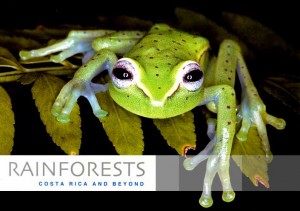Rainforests of Costa Rica and Beyond
Did you know that frogs don’t drink water? It’s true: instead of lapping it up with their tongues in the conventional sense like a dog or a cat, frogs absorb water through their skin. I learned this bit of interesting information, and a lot more, when I recently read Adrian Forsyth’s new book, “Rainforests – Costa Rica and Beyond”. Forsyth, and award winning author and biologist, is definitely at home in the rainforest, drawing on more than forty years of experience as reference to present this publication. And it is some impressive experience that Adrian brings to the table: Vice President of the Blue Moon Fund, Director of Biodiversity Science for the Andean/Amazon Foundation, a PhD from Harvard in tropical ecology, Vice President of Conservation International, a research associate at the Smithsonian Institute, and the list goes on from there. Forsyth is also the author of at least five books ensconced in ecology, including the eye-catching title, “The Natural History of Sex”.
Dr. Forsyth does a nice job of interspersing the topics of his chapters between specific species and general locations. And the photographs by the husband and wife team of Michael and Patricia Fogden work complimentary to the text; indeed they have an impressive display of very unique and very clean, clear shots: enough to merit a book of their own. In fact, they have spent six months a year living in Monteverde for more than three decades and have published two of their own books: “Animals and Their Colours” and “Costa Rica: Wildlife of the National Parks and Preserves”.
There is obviously a delicate balance in nature, and Forsyth does a wonderful job portraying this interdependency, the worlds within worlds in the labyrinth called Nature. He intersperses personal, hands-on experience with scientific fact as well as a little humor in his story-telling, revealing another part of his human side. I especially enjoyed the sections dealing with the co-evolution of an animal and corresponding plant life: the quetzal and avocado’s inter-dependence, for example, as well as the interdependency of the hermit hummingbird and the heliconias, along with all the tributary life systems attached to this relationship, another example of the interwoven fabric of Nature. I was also particularly in awe after reading the chapter about camouflaging techniques used in the rainforest and equally impressed with the accompanying photos.
Dr. Forsyth is an ecologist and there is a message about preserving the planet in the book, but he does a good job waiting until the reader is well into the text to bring up the subject and then he spoon feeds us subtly, rather than cramming it down our throats. Adrian also shares his insights about observing nature in its natural setting and that it is much more beneficial for everyone involved to sit down, be still, and let nature come to you, viewing it in its natural habitat. The book is a beautiful presentation of information and photos. The Forward by E.O. Wilson, himself a research professor in evolutionary biology at Harvard, is testament in itself to the books credibility.
“Rainforests – Costa Rica and Beyond” is available at the Jaime Peligro book stores in Playa Tamarindo, Tilaran and Quepos.


